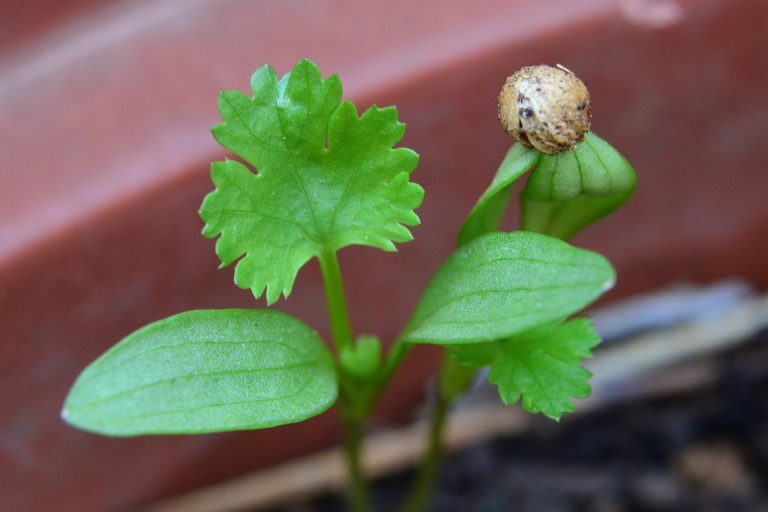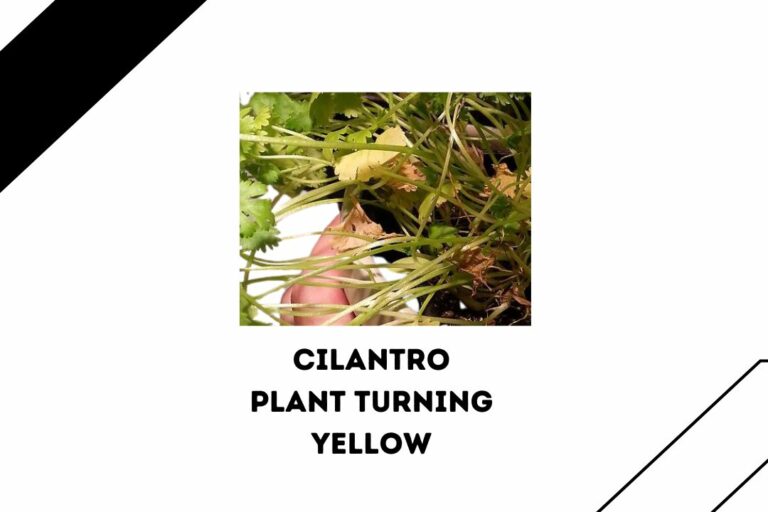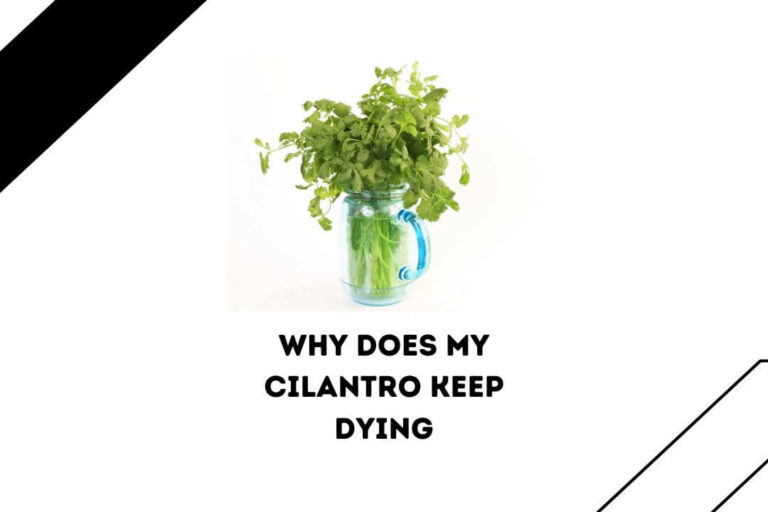Recently I got a query asking why my Cilantro leaves are turning red. If you are also one of them and wondering why sometimes the vibrant green leaves of Cilantro can take on a reddish hue, You are not alone.
This phenomenon is quite common but can be caused due to various reasons,s, which we will discuss in this article. In this article, I will explain why Cilantro leaves turn red and what you can do about it.
Therefore, if you are eager to learn how to fix cilantro leaves turning red, read this article thoroughly. Before I tell you the reasons or the causes of cilantro leaves depending on red, let’s talk about what will happen if you ignore it. In a word, first, we are going to take a quick look at the bizzare consequences of cilantro leaves turning red.
3 Bad Consequences Of Cilantro Leaves Turning Red
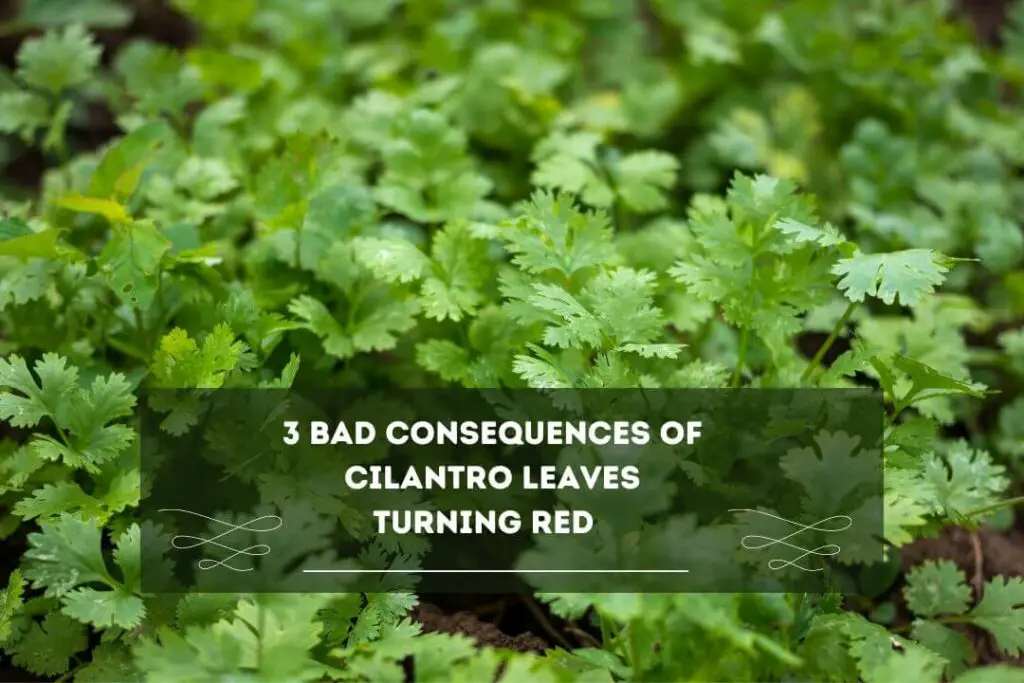
Decreased Nutritional Value
If your cilantro leaves turn red, they can have a lower nutritional value than their green & healthy counterpart. We should also know that red coloration is a sign of plant stress or damage.
It can eventually lead to a significant loss of essential oil & nutrients from the leaves alone. Therefore, eating red cilantro leaves will not provide the same health benefit as greens.
Increased Risk of Disease
Did you know that Reddish cilantro leaves can also be a sign of disease, infection, bacterial leaf spot, or fusarium wilt? Conditions like these tend to spread quickly and, if not paid attention to, r damage the entire plant, leading to lower yields and even death.
According to the University of Colorado Extension, the best way to prevent disease in cilantro plants is to practice good sanitation, including removing infected leaves and avoiding overhead watering.
Unappetizing Appearance
Let’s face it; red cilantro leaves don’t look very appetizing. If you’re using Cilantro as a garnish or ingredient in a dish, the red coloration can make it look unappealing and potentially turn off diners. Even though your cilantro leaf taste may not be affected, the appearance can still impact the overall enjoyment of a meal.
Sometimes, cilantro also starts to look like dill, making it unfavorable to be used as seasoning or decoration on your food. If this is the case, here is what to do if my cilantro looks like dill.
7 Reasons Why Is My Cilantro Turning Red
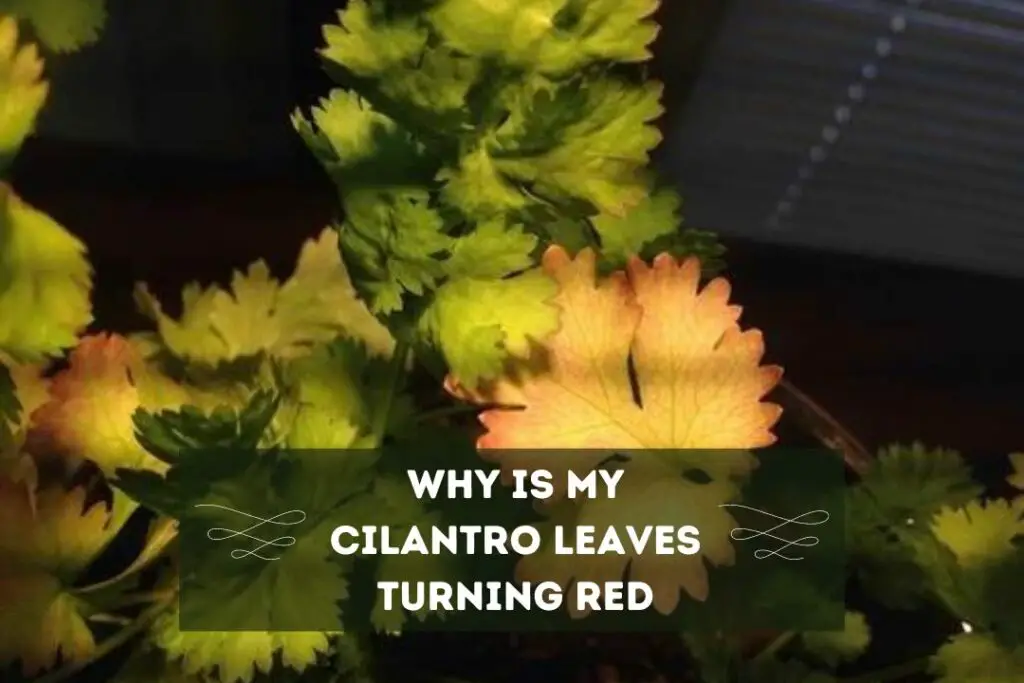
Anthocyanin
Believe it or not, cilantro plants are naturally more prone to producing red leaves if they lack Phosphorus nutrients. When there is a lack of Phosphorus, a cilantro plant pigment called Anthocyanin affects the pigmentation of the leaves.
You need to provide the proper amount of fertilizer and, in this case, extra to prevent this from recurring. It is not necessarily a sign of a dying cilantro plant if it is only deficient in Phosphorus and produces a few red leaves.
Sunburn
Believe it or not, cilantro plants can get sunburned just like humans! If your cilantro plant is exposed to direct sunlight for extended periods, you will likely notice its leaves turning red or brown while becoming crispy.
If this is the case, you need to pay attention and take action promptly because this will put excessive stress on your plant and may even lead to wilting or death. In such an occurrence, I recommend you consider moving your cilantro plants to a shadier location or providing them with some shade cloth.
Lack of Water
Did you know that Cilantro plants need consistent moisture to thrive? Many of my articles have repeatedly discussed the importance of constant humidity and cool temperature for going to cilantro plants.
Cilantro plants’ leaves can become red and brittle if they lack water. In severe cases, your plant may even begin to wilt or die. However, if your Cilantro keeps dying or cilantro seedlings falling over, other factors can be at play. If underwatering is the problem and real culprit for red leaves on cilantro plants, you must water it deeply and frequently, especially during hot, dry weather.
Nutrient Deficiencies
It is important to provide balanced nutrients with the same proportion of nitrogen, Phosphorus, and potassium, like 10-10 fertilizer. Also, make sure to provide organic compost to the soil.
You should know that Cilantro plants require various nutrients to grow healthy leaves. If they are not receiving enough of these nutrients, their leaves may turn red or yellow. This can also be caused due to poor-quality soil or over-fertilization.
Sometimes PH imbalances in the soil cause red leave in cilantro plants. Cilantro plants need a slightly acidic soil with a pH of 6.0 to 6.7, per the University of Michigan Extension.
Pest Infestation
You should know that Cilantro plants are susceptible to various pests, including aphids, spider mites, and whiteflies. All plants are prone to pest infestation if they are not cared for properly.
It is essential to treat these pests because they can suck the sap from the leaves, causing them to turn yellow or red and become distorted. In severe cases, your cilantro plant may even wilt or die if you don’t act promptly.
If your cilantro plant is suffering from test infestation, I recommend using natural or organic pest control methods like Neem oil or insecticidal soap. If the infestation is severe, you must switch to a more robust and robust option. In this case, you might have to use insecticides or pesticides.
Fungal Infections
Like cilantro plants are susceptible to pest infestations, they are also vulnerable to fungal infections like powdery mildew, which can cause their leaves to turn red or yellow. In severe cases, cilantro plant leaves become covered in a white powdery substance.
If you don’t treat it asap, powdery mildew can weaken your Cilantro and lead to lower yields. Make sure your cilantro plants are not overcrowded to prevent fungal infections. In addition to this, you should also avoid overhead watering.
Environmental Stress
Finally, cilantro plants can also become stressed by various environmental factors, including extreme temperatures, high winds, or poor air quality. This can cause your cilantro leaves to turn red or yellow and become brittle. This is why I highly recommend growing cilantro plants in a sheltered location and ensuring they receive good air circulation.
If you notice lots of yellow leaves on cilantro plants, there can be other reasons too. So never mind, take a quick look at this guide, where you will learn seven more reasons for yellow leaves on the cilantro plants.
How To Fix Cilantro Leaves Turning Red
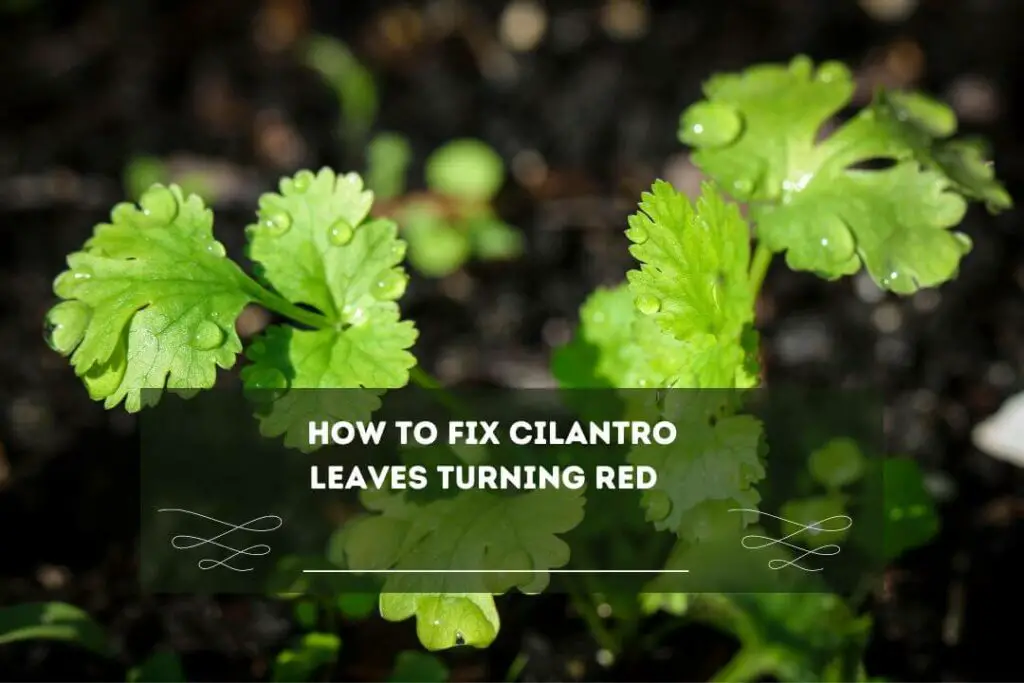
If you want to fix your cilantro leaves turning red, you first need to find the exact cause. The proper treatment will depend upon the culprit. Here are a few things you need to do depending on the type of problem causing leaves to turn red.
- As I told you earlier, one of the main reasons for your cilantro leaves to turn red can be due to pests. Pests like Spider mites and aphids can cause discoloration and damage your plant’s leaves. If this is the case, use insecticidal soap or neem oil spray on your plant.
- You know, underwatering or Overwatering a Cilantro can also cause its leaves to turn red. Adjust your watering schedule if you think your plant is getting too much or too little water.
- Experts recommend providing slightly acidic soil with a pH range of 6.0-7.5 to your cilantro plant. If your soil pH is too high or too low, you can amend it by adding lime or sulfur.
- As you know, Cilantro is a cool-weather crop that prefers temperatures between 50-85°F. If your plant is exposed to extreme heat or cold, it can cause the leaves to turn red. If so, you must move your plant to a more suitable location or provide shade during hot summer days.
- You need to provide a balanced fertilizer with equal amounts of nitrogen, Phosphorus, and potassium because nutrient deficiency might have cost your cilantro leaves to turn red. You should fertilize your plant with a balanced fertilizer once a month at least.
- You should also know that Cilantro needs at least 6 hours of sunlight daily to thrive. If your plant is not getting enough sunlight, move your plant to a brighter location or provide artificial light if needed.
- Some cilantro varieties have red or purple stems and leave due to Anthocyanin. If this is the case, you don’t need to worry much. Just provide the right amount of required nutrients through organic compost or fertilizer to your cilantro plant.
FAQ
Why Is My Cilantro Stems Turning Red?
There are several reasons why Cilantro stems may turn red. One possible cause is stress, which can be caused by improper watering, lack of nutrients, or extreme temperatures. Another probable cause is a fungal infection, like Fusarium wilt, which can cause your Cilantro stems to turn reddish-brown.
What To Do When Cilantro Turns Red Growing In The Garden?
If your Cilantro is turning red, it’s essential to take action as soon as possible to address the underlying cause. You should start by examining your cilantro plant for signs of stress or disease, like wilted or yellowing leaves, then adjust your care accordingly. If the problem persists, you should never hesitate to consult a gardening expert or plant specialist for additional guidance.
Conclusion
I understand that Cilantro turning red can be a frustrating & concerning problem for gardeners and herb enthusiasts alike. However, with the proper care & attention, it is possible to prevent and address this issue.
You must plant your Cilantro in the right location where it will get an adequate amount of shade, morning sunlight, proper watering, and fertilization. It would be best to consider managing pests using organic and natural methods and regularly harvesting your Cilantro.
Without determining the culprit, you should never act as if you might do more harm than good. First, you need to identify the underlying cause and take action promptly to address it.
I tried my best to give you all the information about why Cilantro leaves turn red and what you can do about it. If you find this article, then consider sharing it. Your share will help many people learn why their cilantro leaves turn red and help them take appropriate steps with a systematic approach while following this article.
Check our other helpful guides and reports on cilantro plant care and management. See you in the next post, till then take care and goodbye.


